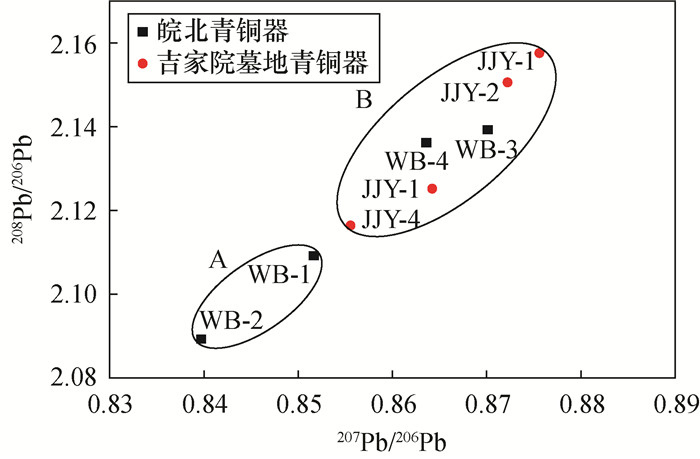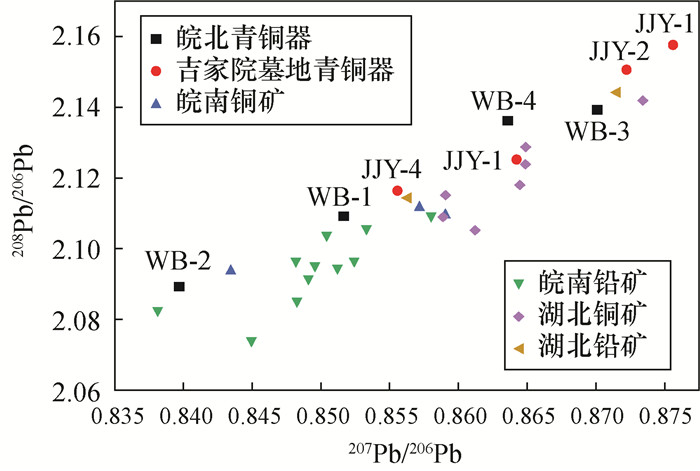Lead Isotope Ratio Analysis of Several Zhou Dynasty Bronzes Unearthed in Northern Anhui Province
-
摘要:
皖北地区地处安徽淮河以北,是先秦时期南北文化交流的重要通道,也是长江中下游铜矿北进中原的必经区域之一,该地区的青铜器对于探讨长江中下游铜矿与中原青铜文化的关系至关重要。本工作采用X射线荧光光谱仪(XRF)和激光剥蚀多接收器等离子体质谱(LA-MC-ICP-MS)对出土于皖北地区4件青铜器及湖北吉家院战国楚墓出土的青铜器进行成分分析和铅同位素比值分析,并与长江中下游的皖南及湖北矿区矿石的铅同位素比值进行了对比研究,以探讨皖北地区青铜器的合金配比及矿料来源。成分测试结果显示皖北4件青铜器中,铅锡青铜3件、锡青铜1件的铜含量范围为60.69%~76.65%,锡含量普遍较高,为9.66%~33.24%,铅含量为0.43%~18.07%,成分波动范围较大。铅同位素比值分析结果显示样品的铅同位素比值均属于普通铅的范围,两件锡青铜(WB-3、JJY-1)指示铜料来源,其余样品反映的都是铅料来源信息。通过与不同地区的矿石进行对比,发现西周时期皖北青铜器和湖北铜绿山矿区的数据较为接近,战国时期皖北青铜器开始使用皖南矿区的矿料,因此从西周至战国,皖北地区所使用的金属资源开始从湖北铜绿山地区逐渐向皖南沿江地区转变。本研究为皖北地区周代青铜器的矿料来源及其与周边地区青铜文化的交流提供了新的科学依据。
Abstract:BACKGROUND The northern Anhui region is located north of the Huaihe River in Anhui. It was an important channel for cultural exchanges between the north and the south during the pre-Qin Period. It was also a necessary area for transporting copper resource on the Yangtze River to the Central Plains. Bronzes in this area are very important for exploring the relationship between copper mines in the Middle-Lower Yangtze River and the bronze culture of the Central Plains.
OBJECTIVES In order to understand the diachronic changes of mineral resources in different periods in northern Anhui and the interaction with the surrounding bronze culture.
METHODS Laser ablation multiple-collector plasma-mass spectrometry (LA-MC-ICP-MS) and X-ray fluorescence spectrometry (XRF) were used to analyze the composition and the lead isotope ratios of 4 bronzes unearthed in northern Anhui and 4 bronzes unearthed from the Warring States Chu Tomb in Jijiayuan, Hubei Province.
RESULTS Results showed that among the 4 bronzes in northern Anhui, there were 3 lead-tin bronzes and 1 tin bronze. The copper content ranged from 60.69% to 76.65%. The tin content was generally higher, 9.66% to 33.24%, and the lead content was 0.43% to 18.07%. The composition had a large variation. The lead isotope analysis results showed that the lead isotope ratios of the samples were within the range of common lead. Two tin bronzes (WB-3, JJY-1) indicated the source of copper materials, and the rest of the samples reflected the source information of lead materials. Comparing the ores in different region, it was found that the data of the bronzes in the northern Anhui during the Western Zhou Period and the Tonglushan mining area in Hubei were relatively close. During the Warring States Period, the bronzes in the northern Anhui began to use minerals from the southern Anhui mining area. Therefore, from the Western Zhou Period to the Warring States Period, the metal resources used in the northern Anhui area began to gradually change from the Tonglushan area in Hubei to the area along the Yangtze River in southern Anhui.
CONCLUSIONS This research provides a new scientific basis for the source of minerals used in bronzes in the Zhou Dynasty in the region, and the exchange of bronze culture between northern Anhui and the surrounding areas.
-

-
表 1 皖北及吉家院青铜器的来源及基本信息
Table 1. Origin and basic information of the bronzes in northern Anhui and Jijiayuan tomb
样品编号 器物名称 考古编号 时代 样品来源 WB-1 铜壶 A: 0006 战国 阜阳市博物馆 WB-2 铜剑 11.0715 战国 阜阳市博物馆 WB-3 铜鼎 11.1113 西周 阜阳市博物馆 WB-4 铁足铜鼎 A0012 战国 阜阳市博物馆 JJY-1 铜壶 M48:77 战国 吉家院48号墓出土 JJY-2 铜剑 M35:10 战国 吉家院35号墓出土 JJY-3 铜盘 M7:12 战国 吉家院7号墓出土 JJY-4 铜器(残) M10:38 战国 吉家院10号墓出土 表 2 样品主要成分和合金类型
Table 2. Main components and alloy types of the samples
样品编号 器物名称 主要成分含量(%) 合金类型 Cu Sn Pb WB-1 铜壶 74.58 13.7 11.42 Cu-Sn-Pb WB-2 铜剑 60.69 33.24 5.8 Cu-Sn-Pb WB-3 铜鼎 76.65 21.41 0.43 Cu-Sn WB-4 铁足铜鼎 72.03 9.66 18.07 Cu-Sn-Pb JJY-1 铜壶 92.44 3.38 0.71 Cu-Sn JJY-2 铜剑 12.47 0.14 62.81 Cu-Pb JJY-3 铜盘 16.07 61.57 13.16 Cu-Sn-Pb JJY-4 铜残器 59.51 24.61 9.49 Cu-Sn-Pb 注:合金成分未作归一化处理。 表 3 样品铅同位素比值数据
Table 3. Lead isotope ratio data of samples
样品编号 样品名称 207Pb/206Pb 208Pb/206Pb 206Pb/204Pb 207Pb/204Pb 208Pb/204Pb WB-1 铜壶 0.85166 2.1092 18.431 15.695 38.877 WB-2 铜剑 0.83969 2.0893 18.630 15.655 38.931 WB-3 铜鼎 0.87009 2.1393 17.924 15.582 38.328 WB-4 铁足铜鼎 0.86359 2.1362 18.085 15.618 38.644 JJY-1 铜壶 0.86423 2.1252 18.051 15.601 38.363 JJY-2 铜剑 0.87223 2.1506 17.910 15.622 38.515 JJY-3 铜盘 0.87561 2.1576 17.808 15.594 38.424 JJY-4 铜器(残) 0.85557 2.1164 18.346 15.696 38.826 -
[1] 张爱冰, 陆勤毅. 皖南出土商代青铜容器的年代与性质[J]. 考古, 2010(6): 83-92. https://www.cnki.com.cn/Article/CJFDTOTAL-KAGU201006009.htm
Zhang A B, Lu Q Y. The age and nature of bronze vessels unearthed from the Shang Dynasty in southern Anhui[J]. Archaeology, 2010(6): 83-92. https://www.cnki.com.cn/Article/CJFDTOTAL-KAGU201006009.htm
[2] 朱凤瀚. 中国青铜器综论[M]. 上海: 上海古籍出版社, 2009: 1207-1208.
Zhu F H. A summary of Chinese bronze ware[M]. Shanghai: Shanghai Ancient Books Publishing House, 2009: 1207-1208.
[3] 周崇云, 陆勤毅, 朱华东. 皖北商周青铜器的发现与初步研究[J]. 安徽史学, 2013(6): 106-111, 118. doi: 10.3969/j.issn.1005-605X.2013.06.013
Zhou C Y, Lu Q Y, Zhu H D. Finding and preliminary study on the bronzes of Shang and Zhou Periods in North Anhui[J]. Historical Research in Anhui, 2013(6): 106-111, 118. doi: 10.3969/j.issn.1005-605X.2013.06.013
[4] 冯志军. 安徽淮北地区商周青铜器研究[D]. 合肥: 安徽大学, 2016.
Feng Z J. Study on the bronzes of Shang and Zhou Periods in the north of Huaihe River in Anhui Province[D]. Hefei: Anhui University, 2016.
[5] 秦颍, 王昌燧, 冯敏, 等. 安徽淮北部分地区出土青铜器的铜矿来源分析[J]. 东南文化, 2004(1): 86-88. doi: 10.3969/j.issn.1001-179X.2004.01.021
Qin Y, Wang C S, Feng M, et al. The analysis on the source of copper material of bronzes unearthed the region north of Huaihe River in Anhui[J]. Southeast Culture, 2004(1): 86-88. doi: 10.3969/j.issn.1001-179X.2004.01.021
[6] 董亚巍, 阚绪杭, 周群, 等. 蚌埠双墩1号墓青铜器群范铸工艺的研究[J]. 文物研究, 2010(17): 240-252.
Dong Y W, Kan X H, Zhou Q, et al. Study on the casting process of the bronze ware group in the No. 1 tomb of Shuangdun in Bengbu[J]. Cultural Relics Research, 2010(17): 240-252.
[7] 胡飞, 秦颖. 蚌埠双墩春秋1号墓部分青铜器成分及金相分析[J]. 有色金属, 2011, 63(1): 153-156. doi: 10.3969/j.issn.1001-0211.2011.01.035
Hu F, Qin Y. The composition and metallographic analysis of some bronzes from Tomb No. 1, Shuangdun, Bengbu in the the Spring and Autumn Period[J]. Non-Ferrous Metals, 2011, 63(1): 153-156. doi: 10.3969/j.issn.1001-0211.2011.01.035
[8] 胡飞, 秦颖, 阚绪杭. 蚌埠双墩1号春秋墓出土部分青铜器产地分析[J]. 文物研究, 2010(17): 253-260.
Hu F, Qin Y, Kan X H. The manufacturing place of some bronze wares unearthed from the Spring and Autumn Tomb No. 1 in Shuangdun, Bengbu[J]. Cultural Relics Research, 2010(17): 2010: 253-260.
[9] 白云翔. 论基于风格与分布的考古遗物产地推定法[J]. 考古, 2016(9): 77-90. https://www.cnki.com.cn/Article/CJFDTOTAL-KAGU201609007.htm
Bai Y X. On the method of predicting the origin of archaeological relics based on style and distribution[J]. Archaeology, 2016(9): 77-90. https://www.cnki.com.cn/Article/CJFDTOTAL-KAGU201609007.htm
[10] 黎海超, 崔剑锋, 盛伟. 湖南宁乡炭河里与望城高砂脊出土铜器的铅同位素分析及相关问题[J]. 考古, 2019(2): 105-114. doi: 10.3969/j.issn.1001-6406.2019.02.016
Li H C, Cui J F, Sheng W. The lead isotope analyses to the bronzes unearthed at Tanheli Site in Ningxiang and Gaoshaji Site in Wangcheng, both in Hunan Province, and relevant issues[J]. Archaeology, 2019(2): 105-114. doi: 10.3969/j.issn.1001-6406.2019.02.016
[11] 黎海超, 崔剑锋. 试论晋、楚间的铜料流通——科技、铭文与考古遗存的综合研究[J]. 考古与文物, 2018(2): 96-101. doi: 10.3969/j.issn.1000-7830.2018.02.009
Li H C, Cui J F. On the circulation of copper materials between Jin and Chu-A comprehensive study of technology, inscriptions and archaeological remains[J]. Archaeology and Cultural Relics, 2018(2): 96-101. doi: 10.3969/j.issn.1000-7830.2018.02.009
[12] 黎海超, 崔剑锋, 周志清, 等. 金沙遗址"祭祀区"出土铜器的生产问题研究[J]. 边疆考古研究, 2019(1): 335-348. http://www.cnki.com.cn/Article/CJFDTotal-BJKG201901019.htm
Li H C, Cui J F, Zhou Z Q, et al. Study on the production of bronze excavated from sacrifice area in Jinsha Site[J]. Research of China's Frontier Archaeology, 2019(1): 335-348. http://www.cnki.com.cn/Article/CJFDTotal-BJKG201901019.htm
[13] Li H C, Zuo Z Q, Cui J F, et al. Copper alloy production in the Warring States Period (475-221 BCE) of the Shu State: A metallurgical study on copper alloy objects of the Baishoulu Cemetery in Chengdu, China[J/OL]. Heritage Science, 2020, doi.org/10.1186/s40494-020-00412-0.
[14] Li H C, Zuo Z Q, Cui J F, et al. Bronze production in the ancient Chengdu Plains: A diachronic metallurgical perspective on a separate cultural region[J]. Journal of Cultural Heritage, 2020, 43: 26-36. doi: 10.1016/j.culher.2019.11.005
[15] Luo W G, Song G D, Hu Y Q, et al. Tentative determination of a special bronze material by multiple technological test on a Xuan-Liu dagger-axe from the Xujialing Site, the Eastern Zhou Period, Henan Province, China[J]. Journal of Cultural Heritage, 2020, 46: 304-312. doi: 10.1016/j.culher.2020.06.016
[16] Chen D, Luo W G, Bai Y X. The social interaction between China and Japanese archipelago during Western Han Dynasty: Comparative study of bronze mirrors from Linzi and Yayoi Sites[J]. Archaeological and Anthropological Sciences, 2019, 11(7): 3449-3457. doi: 10.1007/s12520-018-0763-y
[17] Chen D, Luo W G, Zeng Q S, et al. The lead ores circulation in Central China during the Early Western Han Dynasty: A case study with bronze vessels from the Gejiagou Site[J/OL]. PLOS ONE, 2018, doi: 10.1371/journal.pone.0205866.
[18] Ma D, Luo W G, Qin Y, et al. Study on the casting cores to identify the manufacturing place of Chinese bronze vessels excavated in the Qiaojiayuan tombs from Spring and Autumn Period[J/OL]. Archaeological and Anthropological Sciences, 2020, doi: 10.1007/s12520-020-01169-0.
[19] Luo W G, Song G D, Cui B X, et al. Based on chemical and mineralogical examination of casting cores to determine the foundry area of bronze vessels from the Xiaxiangpu Site in Nanyang City, Henan Province, China[J]. Microchemical Journal, 2019, doi:10.1016/j.microc.2019.104133.
[20] 李瑞亮, 金正耀, 陈彪, 等. 铅同位素比值法研究辽宁东大杖子战国墓地出土铜器的矿料来源[J]. 岩矿测试, 2018, 37(6): 618-625. http://www.ykcs.ac.cn/article/doi/10.15898/j.cnki.11-2131/td.201803220027
Li R L, Jin Z Y, Chen B, et al. Lead isotope study on the source of copper material for bronze vessels in Dongdazhangzi Warring States Period Cemetery, Liaoning Province[J]. Rock and Mineral Analysis, 2018, 37(6): 618-625. http://www.ykcs.ac.cn/article/doi/10.15898/j.cnki.11-2131/td.201803220027
[21] 邓新波. 洛阳战国铁足铜鼎中原与楚文化交融的见证[J]. 大众考古, 2018(4): 82-83. https://www.cnki.com.cn/Article/CJFDTOTAL-KGDZ201804017.htm
Deng X B. Luoyang Warring States iron foot bronze tripod testimony of the blending of Central Plains and Chu Culture[J]. Popular Archaeology, 2018(4): 82-83. https://www.cnki.com.cn/Article/CJFDTOTAL-KGDZ201804017.htm
[22] 朱华东. 安徽淮河流域出土商至春秋吋期青铜器研究[D]. 合肥: 安徽大学, 2018.
Zhu H D. Research on the bronzes of Shang-Sping and Autumn Period unearthed in the area of Anhui Huai River[D]. Hefei: Anhui University, 2018.
[23] 李桃元, 刘志军. 湖北丹江口市吉家院墓地的清理[J]. 考古, 2000(8): 55-64, 100-101. https://www.cnki.com.cn/Article/CJFDTOTAL-KAGU200008005.htm
Li T Y, Liu Z J. Excavation of the cemetery at Jijiayuan in Danjiangkou City, Hubei[J]. Archaeology, 2000(8): 55-64, 100-101. https://www.cnki.com.cn/Article/CJFDTOTAL-KAGU200008005.htm
[24] 廖华军. 吉家院墓地出土青铜器的初步研究[D]. 北京: 中国科学院研究生院, 2008.
Liao H J. A preliminary study of ancient bronzes excavated from Jijiayuan Tombs[D]. Beijing: University of Chinese Academy of Sciences, 2008.
[25] 郁永彬, 陈建立, 梅建军, 等. 关于叶家山青铜器铅同位素比值研究的几个问题[J]. 南方文物, 2016(1): 94-102. doi: 10.3969/j.issn.1004-6275.2016.01.014
Yu Y B, Chen J L, Mei J J, et al. Several questions about the ratio study on lead isotope of the broze ware in Ye Jiashan[J]. Cultural Relics in Southern China, 2016(1): 94-102. doi: 10.3969/j.issn.1004-6275.2016.01.014
[26] 地质部宜昌地质矿产研究所同位素地质研究室. 铅同位素地质研究的基本问题[M]. 北京: 地质出版社, 1979: 55-59.
Isotope Geology Laboratory, Yichang Institute of Geology and Mineral Resources, Ministry of Geology. Basic problems of lead isotope geology[M]. Beijing: Geological Publishing House, 1979: 55-59.
[27] 文娟, 凌雪, 赵丛苍, 等. 安徽六安地区东周楚国青铜器铅同位素特征的初步研究[J]. 西北大学学报(自然科学版), 2013, 43(6): 1016-1020. https://www.cnki.com.cn/Article/CJFDTOTAL-XBDZ201306036.htm
Wen J, Ling X, Zhao C C, et al. Primary analysis on lead isotope characteristics in Chu State bronzes in East-Zhou Period unearthed from Lu'an District, Anhui Province[J]. Journal of Northwest University (Natural Science Edition), 2013, 43(6): 1016-1020. https://www.cnki.com.cn/Article/CJFDTOTAL-XBDZ201306036.htm
[28] 郁永彬, 王开, 陈建立, 等. 皖南地区早期冶铜技术研究的新收获[J]. 考古, 2015(5): 103-113. https://www.cnki.com.cn/Article/CJFDTOTAL-KAGU201505012.htm
Yu Y B, Wang K, Chen J L, et al. New achievements of early copper smelting technology research in southern Anhui[J]. Archaeology, 2015(5): 103-113. https://www.cnki.com.cn/Article/CJFDTOTAL-KAGU201505012.htm
[29] 俞沧海. 安徽铜陵天马山硫金矿床物质来源探讨[J]. 黄金地质, 2000(1): 44-48. https://www.cnki.com.cn/Article/CJFDTOTAL-HJDZ200001006.htm
Yu C H. Study on the origin of materials of Tianmashan sulfur gold deposit in Tongling, Anhui[J]. Gold Geology, 2000(1): 44-48. https://www.cnki.com.cn/Article/CJFDTOTAL-HJDZ200001006.htm
[30] 杨学明, 林文通. 铜官山矿区金口岭铜金矿床围岩蚀变、成矿物理化学条件及成矿机理研究[J]. 地质科学, 1989(4): 323-337. https://www.cnki.com.cn/Article/CJFDTOTAL-DZKX198904004.htm
Yang X M, Lin W T. Studies on wall-rock alteration, physical, chemical conditions, and mechanism of mineralization of Jingkouling copper-gold deposit in Tongguanshan ore field, Anhui Province[J]. Scientia Geological Sinica, 1989(4): 323-337. https://www.cnki.com.cn/Article/CJFDTOTAL-DZKX198904004.htm
[31] 邵毅, 张遵忠, 吴昌志, 等. 安徽铜陵马山层控金铜硫矿床成因[J]. 地质找矿论丛, 2010, 25(4): 310-318, 335. https://www.cnki.com.cn/Article/CJFDTOTAL-DZZK201004010.htm
Shao Y, Zhang Z Z, Wu C Z, et al. Genesis of the Mashan Au-Cu-S deposit, Tongling, Anhui Province[J]. Contributions to Geology and Mineral Resource Research, 2010, 25(4): 310-318, 335. https://www.cnki.com.cn/Article/CJFDTOTAL-DZZK201004010.htm
[32] 王彦博. 湖北铜绿山铜铁矿床地球化学特征与矿床成因[D]. 北京: 中国地质大学(北京), 2012.
Wang Y B. Geochemical characteristics and genesis of the Tonglushan Cu-Fe deposit in Hubei Province[D]. Beijing: China University of Geosciences (Beijing), 2012.
[33] 彭子成, 孙卫东, 黄允兰, 等. 赣鄂皖诸地古代矿料去向的初步研究[J]. 考古, 1997(7): 53-61. https://www.cnki.com.cn/Article/CJFDTOTAL-KAGU199707007.htm
Peng Z C, Sun W D, Huang Y L, et al. A preliminary study on the circulation of ancient metal mineral resources in Jiangxi, Hubei and Anhui provinces[J]. Archaeology, 1997(7): 53-61. https://www.cnki.com.cn/Article/CJFDTOTAL-KAGU199707007.htm
[34] 贾宝剑, 李胜荣, 杨庆雨, 等. 湖北鸡笼山矽卡岩型金铜矿床铅同位素地球化学研究[J]. 现代地质, 2012, 26(3): 471-477, 488. doi: 10.3969/j.issn.1000-8527.2012.03.006
Jia B J, Li S R, Yang Q Y, et al. Pb isotope geochemistry of the Jilongshan skarn-host Au-Cu deposit in Hubei Province[J]. Geoscience, 2012, 26(3): 471-477, 488. doi: 10.3969/j.issn.1000-8527.2012.03.006
-




 下载:
下载:

